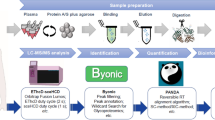Summary
Fabry disease is an X-linked disorder of glycosphingolipid metabolism resulting from a deficiency of the lysosomal enzyme α-galactosidase A. This deficiency leads to the progressive accumulation, in lysosomes of visceral tissues and in body fluids of hemizygotes, of the glycosphingolipids globotriaosylceramide (CTH, Gb3 or GL-3) and galabiosylceramide (CDH) and to a lesser extent the blood group AB and B related glycolipids. Elevated levels of the glycosphingolipids are found in the urine of hemizygous males with the classic phenotype, but it is not known whether all symptomatic or asymptomatic heterozygotes have elevated levels. We have therefore measured CTH and CDH quantitatively in a multiplex assay using tandem mass spectrometry in urine from a large cohort (44) of genetically proven or obligate heterozygotes including four with the N215S mutation, from classic hemizygotes (28), from cardiac variant hemizygotes with the N215S mutation (6) and from normal controls. The levels of CTH and CDH were related to both creatinine and sphingomyelin. Urinary CTH was elevated in all 28 classic hemizygotes but only in 4/6 of the cardiac variants. The level was within or just above the normal reference range in the four individuals heterozygous for the N215S mutation but was elevated in 38/40 of the other heterozygotes. Similar results were obtained for CDH, except that only 34/40 heterozygotes had an elevated level. The level of CDH was not elevated in the four heterozygotes and 4/6 of the hemizygotes for the N215S mutation. Combining the levels of CTH and CDH did not improve the discrimination of heterozygotes from controls. The ratio of CDH to CTH was higher in heterozygotes than in hemizygotes. Measurement of urinary CTH gave the best discrimination of heterozygotes from controls.
Similar content being viewed by others
References
Avila JL, Convit J, Velazquez-Avila G (1973) Fabry’s disease: normal α-galactosidase activity and urinary sediment glycosphingolipid levels in two obligate heterozygotes. Br J Dermatol 89: 149–157.
Berná L, Asfaw B, Conzelmann E, Cerny B, Ledvinova J (1999) Determination of urinary sulfatides and other lipids by combination of reversed-phase and thin layer chromatographies. Anal Biochem 269: 304–311.
Brady RO, Gal AE, Bradley RM, Martensson E, Warshaew AL, Laster L (1967) Enzymatic defect in Fabry’s disease. Ceramidetrihexosidase deficiency. N Engl J Med 276: 1163–1167.
Bishop DF, Calhoun DH, Bernstein HS, Hantzopoulos P, Quinn M, Desnick RJ (1986) Human alpha-galactosidase A: nucleotide sequence of a cDNA clone encoding the mature enzyme. Proc Natl Acad Sci USA 83: 4859–4863.
Boscaro F, Pieraccini G, la Marca G, et al (2002) Rapid quantitation of globotriaosylceramide in human plasma and urine: a potential application for monitoring enzyme replacement therapy in Anderson-Fabry disease. Rapid Commun Mass Spectrom 16: 1507–1514.
Desnick RJ, Dawson G, Desnick SJ, Sweeley CC, Krivit W (1971) Diagnosis of glycosphingolipidoses by urinary sediment analysis. N Engl J Med 284: 739–744.
Desnick RJ, Ioannou YA, Eng CM (2001) α-Galactosidase A deficiency: Fabry disease. In: Scriver CR, Beaudet AL, Sly WS, Valle D, eds; Childs B, Kinzler KW, Vogelstein B, assoc. eds. The Metabolic and Molecular Bases of Inherited Disease, 8th edn. New York: McGraw-Hill, 3733–3774.
Eng CM, Guffon N, Wilcox WR, et al (2001) Safety and efficacy of recombinant human alpha-galactosidase A replacement therapy in Fabry’s disease. N Engl J Med 345: 9–16.
Ko YH, Kim HJ, Roh YS, Park CK, Kwon CK, Park MH (1996) A typical Fabry’s disease. An oligosymptomatic variant. Arch Pathol Lab Med 120: 86–89.
Kornreich R, Bishop DF, Desnick RJ (1989) The gene encoding alpha-galactosidase A and gene rearrangements causing Fabry disease. Trans Assoc Am Phys 102: 30–43.
MacDermot KD, Holmes A, Miners AH (2001) Anderson-Fabry disease. Clinical manifestations and impact of disease in a cohort of 60 obligate carrier females. J Med Genet 38: 769–775.
Mills K, Johnson A, Winchester B (2002) Synthesis of novel internal standards for the quantitative determination of plasma ceramide trihexoside in Fabry disease by tandem mass spectrometry. FEBS Lett 515: 171–176.
Mills K, Vellodi A, Morris P, et al (2004) Monitoring the clinical and biochemical response to enzyme replacement therapy in three children with Fabry disease. Eur J Paediatr 163: 595–603.
Nagao Y, Nakashima H, Fukuhara Y, et al (1991) Hypertrophic cardiomyopathy in late-onset variant of Fabry disease with high residual activity of α-galactosidase A. Clin Genet 39: 233–237.
Oshima M, Asano K, Shibata S, Suzuki Y, Masuzawa M (1990) Urinary neutral glycosphingolipid analysis of patients with Fabry’s disease; rapid isocratic elution from high-performance liquid chromatography as per-o-benzoyl derivatives. Biochim Biophys Acta 1043: 157–160.
Schiffmann R, Kopp JB, Austin III HA, et al (2001) Enzyme replacement therapy in Fabry disease: a randomized controlled trial. JAMA 285: 2743–2749.
Whybra C, Kampmann CHR, Willers I, et al (2001) Anderson-Fabry disease: clinical manifestations of disease in female heterozygotes. J Inherit Metab Dis 24: 715–724.
Young E, Mills K, Morris P, et al (2004) Is globotriaosylceramide a useful biomarker in Fabry disease? Acta Paediatr (in press)
Zeidner KM, Desnick RJ, Ioannou YA (1999) Quantitative determination of globotriaosylceramide by immunodetection of glycolipid-bound recombinant verotoxin B subunit. Anal Biochem 267: 104–113.
Author information
Authors and Affiliations
Corresponding author
Rights and permissions
About this article
Cite this article
Mills, K., Morris, P., Lee, P. et al. Measurement of urinary CDH and CTH by tandem mass spectrometry in patients hemizygous and heterozygous for Fabry disease. J Inherit Metab Dis 28, 35–48 (2005). https://doi.org/10.1007/s10545-005-5263-4
Received:
Accepted:
Issue Date:
DOI: https://doi.org/10.1007/s10545-005-5263-4




